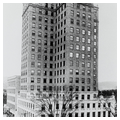You are here
Kanawha Valley Building (Kanawha Valley Bank)
Designed by one of the foremost bank architects of his time—an Englishman on a long American sojourn—the Kanawha Valley Bank claimed the title of West Virginia's tallest building for more than fifty years. It is still among its most distinguished. A bank, the architect wrote in the November 1911 issue of The Bankers Magazine, should be on a prominent site, preferably on a corner, and “should be distinctive,… look like a BANK and … call attention to itself by its substantial and conservative appearance.” Built on a prominent corner (formerly the site of the state capitol), his twenty-story Charleston bank certainly called attention to itself, but not solely by its conservatism. It is a lively, colorful composition that merits the many accolades it has received over the years.
The bank and its offices occupied the rectangular, limestone-clad, three-story base. Above, the shaft is in the shape of a Greek cross. At the top, the central portion of the shaft rises three stories above the wings and terminates in a shallow hipped roof. Large urns above the third floor add punctuation marks, but obelisks that provided a similarly lively silhouette at the seventeenth floor have been removed. The brick walls of the shaft and capital are buff, and the terra-cotta trim is a warm, ruddy, orange hue.
The Kanawha Valley Bank opened September 16, 1929, a culminating monument to the prosperous twenties in Charleston, but not a particularly propitious time for a financial institution. However, thanks to the deep pockets of its founding family, the bank weathered the storm of Black Friday (October 29, 1929). By then, architect Bossom had returned to England, where he soon gave up the practice of architecture for politics. He spent nearly the next three decades in the House of Commons. In 1976 the bank moved to new headquarters a block away, where it continues in operation as One Valley Bank (see next entry).
Writing Credits
If SAH Archipedia has been useful to you, please consider supporting it.
SAH Archipedia tells the story of the United States through its buildings, landscapes, and cities. This freely available resource empowers the public with authoritative knowledge that deepens their understanding and appreciation of the built environment. But the Society of Architectural Historians, which created SAH Archipedia with University of Virginia Press, needs your support to maintain the high-caliber research, writing, photography, cartography, editing, design, and programming that make SAH Archipedia a trusted online resource available to all who value the history of place, heritage tourism, and learning.








